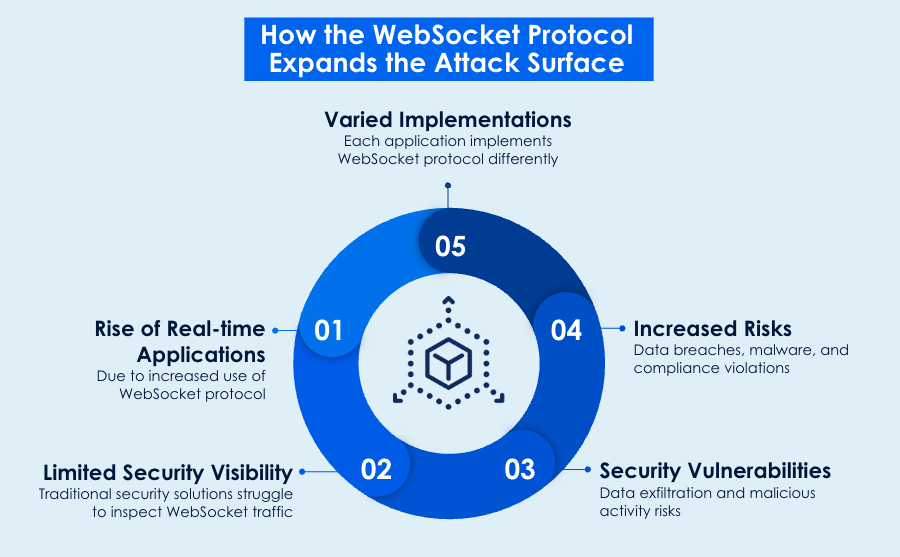Blog de Zscaler
Reciba en su bandeja de entrada las últimas actualizaciones del blog de Zscaler
Suscríbase
Securing AI Communication Protocols with ZIA’s Innovative Cybersecurity Solutions
As organizations adopt generative artificial intelligence (GenAI) to increase the velocity of productivity and decision-making, they must address the security challenges to the enterprise: threat actors can leverage AI to execute attacks under the guise of legitimate traffic.
Zscaler Internet Access’s (ZIA) new WebSocket inspection and forthcoming Zscaler Cybersecurity Copilot ensure that organizations can reap the benefits of GenAI without compromising their security posture with real-time inspection of user prompts submitted to tools like Microsoft Copilot on the web and embedded inside applications.
The Challenges of Securing Generative AI
The adoption of AI apps using WebSocket for client-server communication demands security tooling that bridges the gap between innovation and threats: WebSocket connections enable continuous, real-time interactions between clients and servers, making them essential for AI applications like chatbots, virtual assistants, and other apps that require dynamic data updates. But they also present unique security challenges that traditional security tools struggle to address.
While AI can help organizations be more productive and automate mundane tasks, it presents several challenges from a security perspective:
- Dynamic communication: AI tools rely on the WebSocket protocol for real-time data streaming. Such persistent connections are difficult to inspect with traditional tools resulting in blindspots that threat actors can exploit.
- Encrypted channels: Many AI applications encrypt their traffic using HTTPS and other protocols that can create blockers to inspecting traffic for malicious activity.
- Data leakage risks: Improperly secured AI platforms can become conduits for personally identifiable information (PII) or sensitive data to leave the organization.
- Hidden exploit delivery: AI-based applications might inadvertently allow malicious payloads disguised as normal activity, delivered through encrypted traffic.
- Limited security visibility: Traditional security solutions struggle to inspect WebSocket traffic, resulting in blindspots.
Differing implementations: Application developers can implement the bursty WebSocket protocol differently.

ZIA WebSocket Inspection: Securing Real-Time AI Traffic
To address these vulnerabilities, Zscaler Internet Access (ZIA) can now inspect WebSocket traffic in real-time at scale to prevent AI-driven network communications from being exploited.
Why is WebSocket Inspection Crucial?
Unlike traditional HTTP connections that open and close after each exchange, WebSocket maintain a persistent connection between the client and server. This is ideal for real-time interactions between users and AI-driven applications but also introduces threats like:
- Evasion risks: Persistent connections evade traditional security tools that focus on transactional requests.
- Injection attacks: Malicious payloads can be introduced within the continuous data stream.
- Anomalous behavior: Suspicious behaviors, like unauthorized data downloads, are easier to hide in long-lived WebSocket sessions.
By inspecting WebSocket traffic at scale, ZIA ensures that even real-time, low-latency connections are scrutinized for security threats.
How ZIA Prevents the Security Risk of Generative AI
Zscaler Internet Access takes a layered approach to securing AI-driven environments where the WebSocket protocol is prevalent:
- SSL/TLS inspection: ZIA decrypts encrypted WebSocket traffic without any performance latency, identifying threats hiding within secure channels. This ensures visibility into the real content of AI data streams, whether from chatbots, APIs, or machine-learning systems.
- Real-time content inspection: Persistent WebSocket connections are analyzed for both outbound (data exfiltration) and inbound threats (malicious payloads). ZIA enforces strict security rules across a range of use cases, analyzing traffic in real time.
- Threat intelligence: Augmented by Zscaler’s global threat intelligence gathering and analysis, ZIA continuously updates its database with known threats, identifying behaviors tied to malicious intent within WebSocket and other traffic.
- DLP (Data Loss Prevention): ZIA integrates robust DLP controls to ensure no sensitive information leaves via AI interactions. From chat-based inputs to file generation requests, ZIA prevents accidental or malicious data sharing.
- Zero trust architecture: Every AI-related communication is handled by Zscaler’s Zero Trust framework, where no traffic is trusted implicitly. User activity is continuously verified, regardless of location or device.
How ZIA’s real-time WebSocket Inspection Works
There are many tasks end users leverage GenAI apps for, but imagine for a moment a developer sitting at their desk under deadline pressure to commit code for a new feature. Developers often utilize code libraries from third-party repositories not knowing if there's a vulnerability embedded in the provided code. With inspection policy specified within ZIA, the following scenarios can be effectively dealt with:
- As a developer copy and pastes third-party code into a GenAI prompt and submits it as part of query, ZIA inspects the WebSocket traffic for potential threats or security policy violations and can block the input.
- With the proper policy in place, ZIA ensures secure usage of AI tools like Microsoft Copilot, allowing users to benefit from GenAI while ensuring policy compliance.
- When users try to upload or share sensitive data via Microsoft applications like Sharepoint, ZIA blocks the policy violating action—without impacting app performance.
Zscaler Cybersecurity Copilot: Actionable AI-driven Insights
Building on the foundation of ZDX Copilot, the new Zscaler Cybersecurity Copilot now in development is an AI assistant that helps security and IT teams simplify security operations: using natural language queries, security and IT staff can identify risky user behaviors, detect top threats, and flag suboptimal configurations—all with the goal of accelerating response times with AI-driven insights.
In just minutes, your team will be able to use natural language prompts and up-level actionable insights. Here are just a few examples:
- “Show me top threats that have been blocked including top phishing threats.”
- “Provide a list of users who are making high-risk actions.”
- “What are the top malware files being blocked?”
- “How many instances of LummaStealer occurred last week?”
- “Provide a list of configuration recommendations to improve my security posture.”
Our Product and Engineering teams are working on our Cybersecurity Copilot now and customers will be notified when available.
How ZIA Helps Protect Organizations' AI Adoption
The promise of increased productivity and driving faster outcomes is too great for companies to not allow employees to use AI-drive applications. Aside from outright blocking access to GenAI tools, ZIA customers can allow access to these productivity-enhancing applications yet implement safeguards to prevent data breaches or other malicious uses with:
- Enhancing visibility: ZIA eliminates blind spots in encrypted WebSocket communications, giving organizations comprehensive monitoring of their AI traffic.
- Proactive threat mitigation: By analyzing traffic at scale, ZIA identifies malware, command-and-control communication, or attempts to exploit AI weaknesses before they manifest.
- Enforcing and meeting compliance: With stringent DLP and encryption controls, ZIA helps organizations meet regulatory compliance standards, preserving both trust and security.
- Scalable real-time protection: The cloud-based design of ZIA ensures that even as AI demands grow, security measures scale effortlessly without manual intervention or hardware bottlenecks.
- Securing AI tools in hybrid work: Whether employees are accessing AI platforms from remote locations or within company networks, ZIA enforces consistent security policies, protecting AI-driven workflows wherever they occur.
Stay Secure While Embracing Future AI Advancements
As organizations increasingly adopt AI, threats will continue to evolve as attackers leverage the very systems designed to enhance productivity and decision-making. But with its new AI-specific capabilities, Zscaler Internet Access enables organizations to embrace the promise of AI: by integrating WebSocket inspection with developer environments and empowering security teams with a copilot that will provide actionable information in seconds, ZIA provides the foundation of a secure, AI-driven future.
Register for our launch webinar on April 24 to learn how ZIA's new innovations safeguard AI platforms from cybersecurity threats!
¿Este post ha sido útil?
Reciba en su bandeja de entrada las últimas actualizaciones del blog de Zscaler
Al enviar el formulario, acepta nuestra política de privacidad.





